 Introduction
Introduction
 The INPRISE Strategy
The INPRISE Strategy
 Customer Needs
Customer Needs
 The JBuilder Advantage
The JBuilder Advantage
 JBuilder Product Line
JBuilder Product Line
 Platform Independence
Platform Independence
 Professional Development Tool
Professional Development Tool
 JavaBeans for Increased Productivity
JavaBeans for Increased Productivity
 Enterprise Database Applications
Enterprise Database Applications
 Extensible & Customizable IDE
Extensible & Customizable IDE
 Support & Help for Developers
Support & Help for Developers
Introduction
Since its introduction in 1995, Java™ has mainly been used to enhance Web pages with animated applets. However, Java was designed to be small, easy to learn, and portable across platforms and operating systems. Its full object-oriented programming language modeled after C++ and its platform independence appeal has attracted the attention of many developers.
Today, serious programmers are considering Java as a true programming language to create robust business applications. Following the introduction of JDK 1.1 in February 1997, developers are now actively seeking a more mature, reliable, extensible, and scalable second-generation tool that will allow them to create platform-independent, robust business applications.
Now for the first time, there is a second-generation Java tool — JBuilder —
designed to meet the needs of corporations and businesses. JBuilder bridges client/server systems and emerging multi-tier and Internet/intranet architectures and provides corporate users with a further bridge from legacy to new applications and systems.
The INPRISE Strategy
The INPRISE Information Network Strategy
As a critical part of its new focus, INPRISE plans to combine its unique object-oriented development tools, middleware technologies, and open architecture to allow users to create powerful applications that provide cross-platform access and analysis of corporate data over intranets, extranets, and the Internet. INPRISE plans to bring to market new technologies and products that support connectivity to enterprise applications, distributed application management, and decision-support capabilities.
Construction of corporate Information Networks, offering cross-platform access to valuable information and enterprise-wide applications, represents one of the most potent opportunities facing IT organizations in the late 1990s. Yet, no company has stepped forward to deliver the solutions needed to enable rapid development of these integrated Information Networks. Most software tools providers have focused on supporting a single platform or proprietary system and do not offer the breadth of tools necessary for designing these powerful, next-generation information technology solutions.
"The tidal wave of software technologies unveiled during the 1990s present the corporate developer with wonderful opportunities to deliver high-value solutions to their company. Unfortunately, dealing with idiosyncratic low-level APIs prevents corporate developers from taking advantage of the latest technologies. INPRISE's Information Network vision correctly moves developer emphasis to building solutions and hides the unnecessary complexities. INPRISE's integrated breadth of open tools and middleware products are obvious choices for Information Network development. "
Evan Quinn, Research Director of Java and Internet Software, International Data Corporation
The Information Network will become an essential, cost-effective computing platform for corporate customers during the next three years. Corporate IT will experience an increasing convergence of client/server with Internet and intranet application development technologies and technologies for decision support and online analytical processing.
The key foundations of the Information Network architecture include: enterprise-class application development tools, Java/Web integration, and rich information analysis. To deliver on this strategy INPRISE combines: superior development tools, a large and growing library of data analysis components, and above all, no platform agenda. With its new Java Development Environment — JBuilder — INPRISE delivers what developers care about most: higher productivity and full support for Pure Java industry standards.
The INPRISE Java Strategy
INPRISE was one the first companies to license Java from Sun Microsystems. As a key partner of Sun, INPRISE was significantly involved in the Java JDK development.
INPRISE's focus is to leverage its experience as a leader in development tools and deliver a state-of-the-art Pure Java development tool — JBuilder — that meets developers' requirements and gives their business a competitive advantage.
"Following the release and enthusiastic market response to INPRISE's Delphi™, we are excited about INPRISE applying its core technology and expertise to a Java development environment. INPRISE tools will help to position Java as the platform of choice for a new generation of distributed computing applications."
Eric Schmidt, Chief Technology Officer for Sun Microsystems
"INPRISE's expertise in component-based development tools such as Delphi is a valuable asset to the Java community, and JavaSoft is excited about component-based Java RAD tools such as JBuilder."
David Spenhoff, Director of Product Marketing for JavaSoft
Customer Needs
INPRISE has established itself as the leading development tool vendor by listening to developers and by delivering superior tools to the market. To make sure that a tool meets customers' requirements, INPRISE involves key developers and businesses in the tool's early stages of development. A sample representative of the market is selected by including Fortune 100 to Fortune 1000 companies, VARs, IT Managers, Independent Consultants, and more. In addition, product teams conduct substantial marketing research, including focus groups and thorough study of market trends and industry needs. Research findings highlight the following requirements for Java developers:
Platform Independence
The whole idea of " Write Once and Run Anywhere" has been a developer's dream for a long time. Since Java has now become the de facto standard for platform-independent development at the enterprise level, it makes sense for corporations to develop and deploy their applications in Java. To deliver on the promise of "Write Once, Run Anywhere," development tools need to generate 100% Pure Java Code.
Reliability
To handle professional applications, the tool itself and its inherent technology need to be robust. The first generation of Java development tools, based on the early JDK 1.0.2, failed in delivering the robustness necessary to create Java applications for the Enterprise. The new JDK 1.1, however, with significant improvements on database connectivity, components, security, internationalization, and more, offers a much-improved environment. Therefore, a Java development tool needs to be built on top of the JDK 1.1.
Extensibility
In the rapidly evolving Java arena, developers require a development tool that offers an open and extensible architecture to let them easily expand and enhance the development environment as their needs evolve. Such a tool should make it easy for developers to integrate their favorite CASE tools, testing tools, version control, Wizards, and commercial JavaBeans™. It should also support multiple VMs, new drivers, new tools, and new file types.
Scalability
As corporate developers face increasing demands for information delivery, some critical decisions need to be made. What's the best way to integrate current client/server technology with the exploding use of corporate intranets and emerging use of the Web? Can the applications handle increase in the volume of users, data, and transactions? How can developers quickly build robust applications that are scalable, that will work across all platforms, and that will preserve investment in systems and corporate data?
Java developers' ideal development tool should create applications that can scale from interactive applets for Web pages to platform-independent, multi-tier applications for use across the entire enterprise.
Java Development Tool Requirements:
To satisfy the most important needs and wants of Java developers, professional development tools need to provide the following:
- 100% Pure Java Code creation for complete platform independence.
- JavaBeans support, creation, and deployment for increased productivity through component reuse.
- Pure Java Two-Way-Tools™ for complete control over Java code.
- Open architecture for the flexibility of adding components, beans, Wizards, editors, CASE tools, etc. to tailor the tool to their specific needs.
- Productive environment with a professional compiler, debugger, editor, and project manager for faster development cycles.
- Full database integration and tools to create applications that can scale from a Web applet to complete client/server and multi-tier applications.
The JBuilder Advantage
"JBuilder represents an exciting new evolutionary step for INPRISE. As the leader in providing high-performance, high-productivity visual development tools for Windows and client/server computing, we are bringing this experience to the platform-independent world of Java and the new generation of corporate 'Information Network' applications. We invite all software developers to take a look at what an industrial-strength Java development environment should be: INPRISE JBuilder."
Del Yocam, INPRISE President and CEO
INPRISE JBuilder is a family of highly productive, visual development tools for creating high-performance, platform-independent applications using the Java programming language created by Sun Microsystems. The JBuilder scalable, component-based environment is designed for all levels of " Information Network " development projects, ranging from applets and applications that require networked database connectivity to client/server and enterprise-wide, distributed multi-tier computing solutions. The JBuilder open environment supports 100% Pure Java, JavaBeans, JDK 1.1, JFC, RMI, CORBA, JDBC, ODBC, and all major corporate database servers. JBuilder will also provide developers with a flexible open architecture to incorporate third-party tools, add-ins, and JavaBean components.
"We needed a professional development tool to build our corporate Java applications. Our requirements were simple: 100% Java code, complete JDBC and JavaBeans support, and a professional IDE. Unlike other Java tools, JBuilder true Two¡Way¡Tools generate pure Java code, with no hidden tags or macros. We have evaluated most of the tools available on the market, and only JBuilder met our strict criteria. Unlike Visual J++ and Symantec Cafe, which lock you into one middle-tier architecture that we didn't care for, the code generated by INPRISE JBuilder is 100% Pure Java. "
Patrick Ryan, Design Engineer at Hobart Corporation,
The world's leading supplier of food equipment and service to the food service and food retail industries
JBuilder - The Choice of IT Leaders
After a thorough investigation of several Java development tools, Oracle has licensed JBuilder for its superior technology, highest quality, and best architecture. All internal Java development at Oracle will be done using JBuilder. Oracle has also chosen to promote JBuilder to its customer base because of the JBuilder DataExpress, a state-of-the art database architecture with superior support for the Oracle DBMS.
"Oracle licensed INPRISE's JBuilder because of its superior Java technology. INPRISE's pure Java approach is the right approach for customers who are looking to maximize the benefits of network computing — no client administration, complete portability, and standards compliance. "
Sohaib Abbasi, Senior Vice President, Oracle Tools.
"INPRISE and IBM are forging a strong partnership for the future. The synergy we are building through the optimization of the JBuilder development environment to take advantage of San Francisco business process components will speed San Francisco-based applications to the market. The continued strong relationship will drive benefits to San Francisco, JBuilder, and our mutual customers. "
Steve Ladwig, General Manager, Network Computing and Solutions Frameworks,
IBM Worldwide General Business.
JBuilder - Platform-independent Solutions
To deliver on the promise of " Write Once, Run Anywhere, " JBuilder was architected to generate only 100% Pure Java code. All applications, applets, or JavaBeans created with JBuilder can work on any platform running a Java Virtual Machine: Windows, Unix, Mac, AS/400, mainframes, etc. They will also work in any browser supporting JDK 1.1.
JBuilder - The Most Powerful Development Environment
JBuilder leverages the technology that made INPRISE's development tools the preferred tools for high-end developers. It includes a lightning-fast compiler able to compile more than 10,000 lines of code a second. Its unique advanced SmartChecker™ feature offers the fastest rebuild/recompile speeds by compiling only files where changes have been made.
JBuilder also includes a graphical debugger with all the features professional developers need to easily find and fix bugs. For faster development cycles, this professional debugger includes breakpoint setting, multi-thread support, single-step through the code, etc.
JBuilder - Java Extensibility with JavaBeans
To increase developers' productivity by encouraging component reuse, JBuilder features BeansExpress™, the fastest and easiest way to build JDK 1.1-compliant JavaBean components. With BeansExpress, developers can visually create components from scratch, or combine a number of existing components into a new JavaBean. BeansExpress will also allow developers to easily deploy their JavaBeans in any Java environment or add them to the easy-to-navigate JBuilder component palette.
JBuilder Professional and Client/Server Suite will also ship with more than 100 reusable JavaBeans for GUI design, Internet development and database access, including Grid, Tree, Navigator, Image, Checkbox, Choice, Picklist, Field, List, Locator, ButtonBar, StatusBar, and many more. Source code for these components will be included. In addition, each version of JBuilder includes a set of award-winning JavaBeans from KL Group and JavaSoft's standard AWT components.
"We have selected INPRISE JBuilder to develop our commercial JavaBean components: Objective Blend and Objective Grid for Java. JBuilder offers the fastest way to create and deploy JavaBean components with Java BeansExpress. The JBuilder component architecture and its full support for the JavaBean standard make it the preferred development tool for professional JavaBeans development."
Bill Loeb, Chief Java Architect at Stingray Software
JBuilder - The First Industrial-strength Enterprise Tool
Organizations that excel at managing and acting on corporate data gain a competitive advantage. Only the JBuilder DataExpress architecture enables developers to build thin multi-tier applications, using industry-standard JDBC connectivity, and any database server, including Oracle, DB2, Sybase, MS SQL Server, Informix, and InterBase.
Building sophisticated database applications is easy with drag-and-drop, data-aware JavaBeans, including Grid, Chart, Navigator, TableDataSet, TextDataFile, QueryDataSet, QueryResolver, and DataSetView. With JBuilder, developers get full support for master-detail, sorting, filtering, aggregation, calc fields, picklists, edit constraints, display formatting, and more.
JBuilder - The Most Productive and Customizable IDE
The JBuilder RAD Workbench is designed for maximum productivity. Developers will welcome its Rapid Application Development based on the professional IDE that made INPRISE tools, such as Delphi and C++Builder, so successful. Developers can customize JBuilder to their liking by including their own tools, their preferred editor or designer, or by adding commercial JavaBeans, Wizards, etc. Based on the JavaBeans component model, JBuilder delivers the most productive environment with component reuse. Developers can be up and running in no time with the intuitive application browser (AppBrowser) for project management, numerous Wizards, and more.
JBuilder - Unique Comprehensive Support and Help to Developers
JBuilder includes comprehensive Help and documentation with reference books for new Java users and advanced developers. JBuilder was designed to decrease developers' learning curve by providing them with an easy-to-use and easy-to-learn interface and thorough documentation. In addition, only JBuilder includes a "Welcome Project" for a smooth start in programming with JBuilder, a simple-to-use all-HTML help file with a browser look and feel, online Java Docs for full Java reference, and more.
JBuilder Product Line
JBuilder has been designed to answer the needs of a range of developers, from the new Java developer to the most advanced business developer. To satisfy all developers needs, JBuilder comes in three different editions: Professional, Client/Server Suite, and Standard.
JBuilder Professional
JBuilder Professional was designed with business application development needs in mind. It is the perfect development environment for developers creating robust database applications. JBuilder Professional was specially engineered to deliver the ease-of-use, scalability, reliability, and extensibility that professional developers need. You get everything in JBuilder Standard, including Java BeansExpress, plus: drag-and-drop database components and tools, complete JDBC connectivity, more than 100 JBCL JavaBeans, including grid with source code, charting, numerous Wizards, command-line tools, and Local InterBase.
JBuilder Client/Server Suite
JBuilder Client/Server suite was designed for developers of enterprise projects requiring robust, scalable, multi-tier client/server applications. JBuilder Client/Server Suite is the most comprehensive set of visual development tools for creating Pure Java client and server applications for the enterprise. Deliver scalable multi-tier applications with full support for RMI and CORBA. It includes everything in JBuilder Professional, plus: RMI, Visigenic VisiBroker for CORBA, and InterBase NT. In addition, you get the complete source code of a sample multi-tier CORBA reference application. You also get integrated SQL Builder, SQL Explorer and SQL Monitor, and DataGateway for Java with high-performance native drivers for Oracle, Sybase, Informix, DB2, InterBase, MS SQL Server, MS Access, FoxPro, Paradox, and dBASE.
JBuilder Standard
JBuilder Standard was designed with beginning Java programmers in mind. It is the perfect development tool for Java beginners, as well as for advanced programmers. Deliver JavaBean components in record time with Java BeansExpress. Create pure Java applications or applets for the coolest Internet programs and Web pages. JBuilder Standard also includes the step-by-step tutorial, Teach Yourself JBuilder in 14 Days, with sample applications and source code.
JBuilder Feature Comparison Chart
Platform Independence
JBuilder creates 100% Java code and carries the Java-compatible logo on the box. Since INPRISE has no platform agenda, developers can be assured that everything they write with JBuilder is Pure Java and fully platform-independent.
Full Support for Pure Java Standards
In addition, JBuilder creates Pure Java applications that support all Java standards, including JDK1.1, JavaBeans, JFC, JARs, JNI, Internationalization, JDBC, RMI, IIOP, and CORBA. JBuilder applications will run in any Java environment.
Professional Development Tool
The JBuilder Environment
A tremendous effort has been made to deliver an easy-to-use, easy-to-learn, yet highly productive environment for JBuilder. We leveraged the highly successful RAD Workbench IDE from Delphi and C++Builder and conducted thorough usability testing. This is where the Application Browser or AppBrowser was born. The result is a very enticing interface that's been praised by all Java developers using JBuilder. Let's have a look at the JBuilder IDE.
 The JBuilder Main Window and AppBrowser deliver an intuitive interface
The JBuilder Main Window and AppBrowser deliver an intuitive interface
The Main Window
The window at the top of the screen is called the main window. This window contains the menu bar, tool bar, and the Component Palette.
 The JBuilder Main Window
The JBuilder Main Window
An easy-to-navigate window with a Delphi and C++Builder feel
The Component Palette
The Component Palette displays the components that are available in the JBuilder component library. The components are grouped on pages to help organize components that are similar.

The JBuilder Component Palette includes more than 60 Visual JavaBeans with Source Code
The AppBrowser
The JBuilder RAD Workbench is designed to increase the productivity of the developer. A Java project can consist of many files. Different development tasks (such as editing or debugging) have historically used many windows, which can clutter the desktop and make it hard to find the window you need. The JBuilder new IDE concept is a single window called the AppBrowser, that performs all of the development tasks. The AppBrowser is found below the main window and fills the rest of the screen.
The AppBrowser contains three panes:
- The Navigation Pane, on the upper left
- The Content Pane, on the right side
- The Structure Pane, on the bottom left
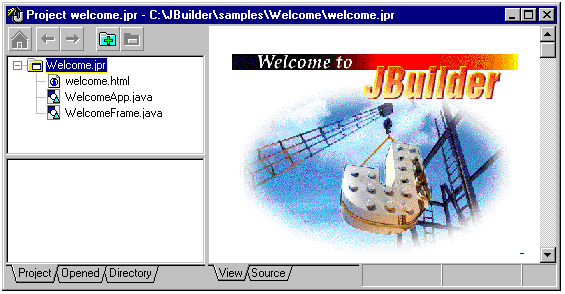
The AppBrowser gives an intuitive browser view of project files, components, methods, variables, imports, etc.
- Open multiple AppBrowsers to view more than one project at a time.
The Navigation Pane
The Navigation Pane is the top left pane of the AppBrowser. This pane shows a list of files. If there is a project in this pane — file with a JPR extension — a tree view will show all the files associated with the project. When you select a file in the Navigation pane, the Content and Structure pane will change to represent the selected file.
The Structure Pane
The Structure Pane is the lower left pane of the AppBrowser. This pane shows a structured analysis of the file selected in the Navigation pane. For example, a selected file with a JAVA extension will show the following in the Structure pane:
- Imported packages
- The classes and/or interfaces in the file
- The ancestry of classes and/or interfaces
- Variables and methods
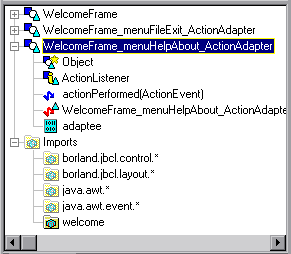
The Structure Pane facilitates management of classes, variables, methods, etc.
The Content Pane
The Content Pane is found on the right side of the AppBrowser. This pane shows detailed information about the file selected in the Navigation pane. The editor or viewer used to display the information is determined by the file's extension.
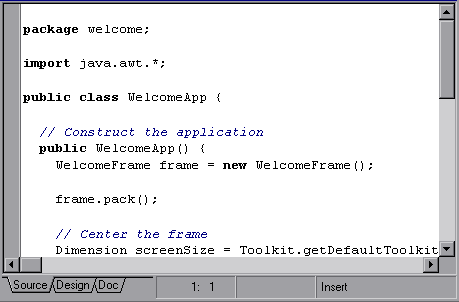
The Content Pane supports color syntax highlighting for easy code editing
- The number and types of viewers/editors depends on the file's extension. For example:
- Text files will only have a Source tab
- Image files will only have a View tab
- HTML files will have a View and a Source tab
- JAVA files will have a Design, Source, and a Doc tab
The AppBrowser can display the following modes:
- Project Browser
- Directory Browser
- Opened Files Browser
- Debugger
- Class Hierarchy Browser
- Search Results Browser
The Object Gallery
The Object Gallery contains shortcuts that aid developers in the construction of many objects. To view the Object Gallery, choose File |New.
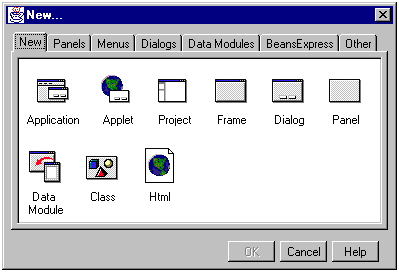
The Object Gallery includes Wizards and templates for faster development
The Object Gallery has seven tabbed pages
- The New page will help create applications, applets, projects, etc.
- The Panels page will help create a Tabbed Pages panel and a Dual List dialog
- The Menu page contains a standard menu
- The Dialog page will help create an about box and some standard dialogs
- The DataModule page contains templates to create data modules
- The BeansExpress page will aid in the creation of JavaBeans
The Other page contains an example for creating a snippet
Pure Java Two-Way-Tools
INPRISE's unique Two-Way Tools let developers work simultaneously in the visual designers and pure Java code by switching between the Design and Source tabs, so they get all the benefits of visual programming without sacrificing the control of working in code. Because JBuilder doesn't use markers in the code to keep the two synchronized (markers that can be inadvertently deleted), developers never have to worry about getting out of sync and thereby losing the ability to do visual design!
Advanced Java Compiler
The JBuilder compiler has full support for the Java language, including inner classes and JAR files. Developers can compile from within the IDE, or from the command line.
SmartChecker for Smart Dependencies Checking
JBuilder can compile more than 10,000 lines of code per second. Moreover, only JBuilder offers the fastest rebuild/recompile speeds by using Smart Dependency Checking, which results in fewer unnecessary compiles of interdependent source files, and thus accelerates the edit/recompile cycle. When compiling, instead of deciding whether to recompile a source file based only on the time stamp of the file, JBuilder analyzes the nature of the changes made to source files. A source file is recompiled only if it uses (or depends on) a particular element that has changed within another source file.
Types of compiling
There are two commands for compiling: the Make command, and the Build command. The Make command compiles only the files that have changed. Make is the recommended command. The Build command compiles all the files.
Powerful Debugger
Any programmer knows that debugging can be a very painful process. That is why an integrated debugger is essential in any programming environment. The JBuilder professional debugger makes the process of locating and fixing errors in the code much easier. It enables developers to control the execution of their program by:
- tracing into or stepping over a method call
- running to a breakpoint
- running to the cursor location
- running to the end of a method
- pausing the program at a certain location or when a condition is met
With the program's execution under control, developers can then inspect or change object properties and variable values during execution to locate any bugs. This can be done using:
- the Threads and Stack pane
- the Data pane
- the Inspector
- the Evaluate/Modify dialog box
Debugging in a Browser
An applet runs in an HTML page, from which it obtains its display size and other parameters. To run or debug an applet in JBuilder, select the .html file in the project tree of the AppBrowser, and select Run | Run or Run | Debug.
Debugging Multiple Projects
Developers can debug multiple projects in JBuilder just by switching between several AppBrowser instances.
Multi-threaded Debugging
With JBuilder, a developer can debug multi-threaded applets, applications, and JavaBeans. It is easy to examine Stack frames and variables of all threads in the AppBrowser.
Starting the Debugger
To start the debugger, first open the project to debug. Once the project is open, select File | Project Properties and make sure that Include Debug Information is checked.
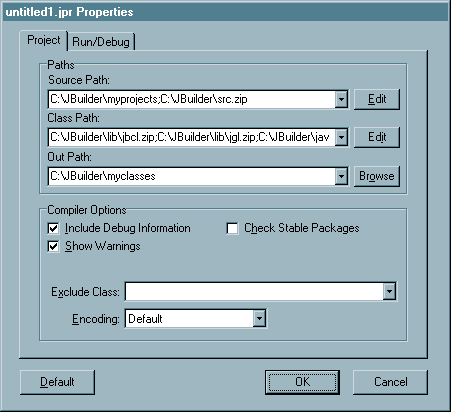
The JBuilder extensible environment makes the Debugger Customization easy
Select the .jpr node in the Navigation pane. To start the debugger, either select Run | Debug, press F9, or click the Debug icon:

JBuilder first compiles the project files and then starts the debugger. While in debugging mode, the program executes as it normally would, but now it can be paused at any given point to check its state at that point.
The debugger adds two tabs to the AppBrowser's Navigation pane: Debug and Watch.

The Debug tab displays the Threads and stack pane (the top pane), and the Data pane.
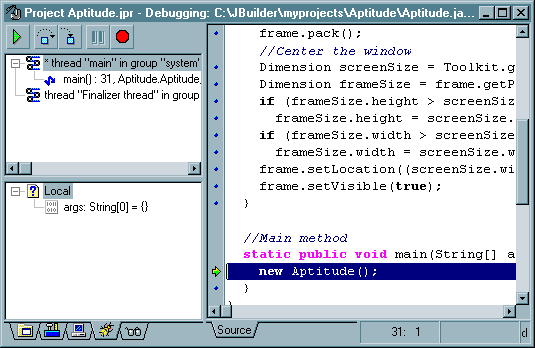
The JBuilder graphical debugger makes bug fixes a snap
Use the Threads and Stack pane to view the methods called and the states of program threads. To inspect data elements, use the Data pane.
The Watch tab shows the Watch pane, which can be used to evaluate variables and expressions.
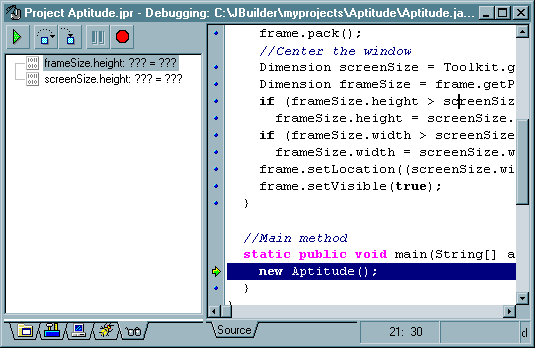
The icons (from left to right) are used to execute the program, step over a method call, trace into a method call, pause the execution, and reset (stop) the debugging process.
If the project files compiled successfully, the Debugger will highlight the line of code that it will execute next in blue, and display a green arrow next to it. This is called the execution point.
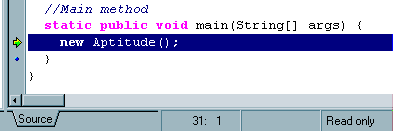
To find the execution point at any time during debugging, select Run | Show Execution Point.
If the compiler encounters any errors before the Debugger starts, the errors will be listed in the bottom section of the Source pane, and a red highlight shows the first error.
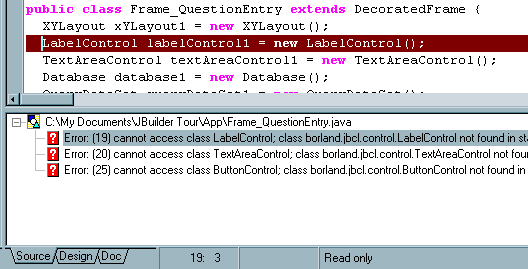
The JBuilder graphical debugger gives comprehensive error messages for easier debugging
than 10 years of experience in compilers and debuggers, INPRISE delivers the most mature and reliable compiler and debugger technology to the Java developers community. This industrial-strength environment development makes JBuilder the preferred Java development for professional developers.
Continue to next page...

 Introduction
Introduction The INPRISE Strategy
The INPRISE Strategy Customer Needs
Customer Needs The JBuilder Advantage
The JBuilder Advantage JBuilder Product Line
JBuilder Product Line Platform Independence
Platform Independence Professional Development Tool
Professional Development Tool JavaBeans for Increased Productivity
JavaBeans for Increased Productivity Enterprise Database Applications
Enterprise Database Applications Extensible & Customizable IDE
Extensible & Customizable IDE Support & Help for Developers
Support & Help for Developers










